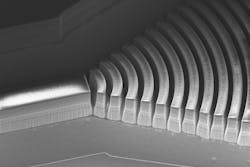DCM and QCL combo outmaneuvers dispersion for LWIR frequency combs
A group of researchers from MIT, General Dynamics Mission Systems, Thorlabs Quantum Electronics, and the University of Texas at Austin recently designed and demonstrated a compact on-chip measurement platform with an air-dielectric slab DCM and QCL combo that generates a stable LWIR frequency comb.
It provides the “missing link” of scalability and flexibility for mass-producible remote sensors and portable spectrometers (see video).
Frequency combs generate spectra with discreet and equally spaced lines—akin to a comb’s teeth. “In short, frequency combs can be viewed as rulers of frequency,” says Qing Hu, a professor of electrical engineering and computer science at MIT, who led the group’s work.
Until now, designing frequency combs with the bandwidth required for mass-producible remote sensors and portable spectrometers was a challenge because they required bulky components that limited both scalability and performance.
The LWIR range—8 to 13 µm—is “rich in spectral fingerprints and also coincides with a highly transparent atmospheric window,” Hu explains. “LWIR frequency combs will enable spectroscopy and sensing, both remote and standoff, with high frequency resolution within a compact system—without mechanically moving parts.”
Dispersion, dispersion, dispersion
Dispersion (laser lines not evenly spaced) is an enormous challenge with LWIR radiation and tends to limit a frequency comb’s bandwidth, so Hu’s group set out to find a way to outmaneuver it.
Earlier, the group had found a way to work around dispersion of a frequency comb that used terahertz waves by using a DCM (its corrugated structure effectively compensates for dispersion).
But when they tried using this trick on an infrared (IR) comb, they hit a wall. They eventually realized that while they’d designed their mirror with corrugation for terahertz lasers because they’re lossy, IR radiation sources aren’t as lossy when unbiased and a standard DCM design is compatible with IR radiation and compensates for dispersion.
The group’s method is based on broadband lasers, “specifically, QCLs,” says Hu. “Even though the lasing spectra can be broad, without special care the lasing lines will not be equally spaced and there’s no phase coherence among them.”
Dispersion makes “lasing lines unequally spaced, which is incompatible with comb formation,” Hu says. “Our ‘aha’ moment came when we realized that the original form of DCM (invented in 1997) can be implemented with LWIR QCLs and compensate their inherent dispersion to form laser frequency combs.”
One challenge Hu’s group faced was creating curved mirror layers to capture the divergent LWIR QCL’s beam, which made fabrication extremely difficult, in part, because the mirror layers differ only by tens of nanometers. To do it, they turned to electron-beam lithography and deep dry etching (standard photolithography was ruled out).
But the biggest challenge was “dispersion, dispersion, and dispersion,” Hu says, borrowing from real estate agents’ favorite phrase: Location, location, location. “Within the context of frequency combs, with the availability of broadband gain media, the most important challenge is dispersion.”
What does the group’s advance mean for spectrometers and other test/measurement applications? “It’s a promising type of spectrometer and sensor—with high frequency resolution and signal/noise ratio—and it’s fast and compact,” Hu says.
Timeline? “It will be an iterative process,” says Hu. “The broader the combs’ bandwidth, the more useful they are for spectroscopy and sensing applications. Again, with the availability of broadband gain media, dispersion is the most important obstacle for the development of broadband combs. Our work provides a powerful and versatile method to measure and compensate dispersion with arbitrary form over a very broad bandwidth.”
The group’s work received funding, in part, from the U.S. Defense Advanced Research Projects Agency (DARPA) and the Gordon and Betty Moore Foundation.
FURTHER READING
T. Zeng et al., Light Sci. Appl., 14, 280 (2025); https://doi.org/10.1038/s41377-025-01961-4.
About the Author
Sally Cole Johnson
Editor in Chief
Sally Cole Johnson, Laser Focus World’s editor in chief, is a science and technology journalist who specializes in physics and semiconductors.

